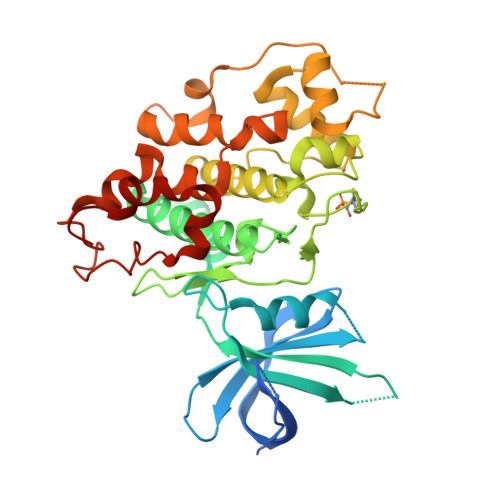Discovery of a Highly Selective Glycogen Synthase Kinase-3 Inhibitor (PF-04802367) That Modulates Tau Phosphorylation in the Brain: Translation for PET Neuroimaging.
Liang, S.H., Chen, J.M., Normandin, M.D., Chang, J.S., Chang, G.C., Taylor, C.K., Trapa, P., Plummer, M.S., Para, K.S., Conn, E.L., Lopresti-Morrow, L., Lanyon, L.F., Cook, J.M., Richter, K.E., Nolan, C.E., Schachter, J.B., Janat, F., Che, Y., Shanmugasundaram, V., Lefker, B.A., Enerson, B.E., Livni, E., Wang, L., Guehl, N.J., Patnaik, D., Wagner, F.F., Perlis, R., Holson, E.B., Haggarty, S.J., El Fakhri, G., Kurumbail, R.G., Vasdev, N.(2016) Angew Chem Int Ed Engl 55: 9601-9605
- PubMed: 27355874
- DOI: https://doi.org/10.1002/anie.201603797
- Primary Citation of Related Structures:
5K5N - PubMed Abstract:
Glycogen synthase kinase-3 (GSK-3) regulates multiple cellular processes in diabetes, oncology, and neurology. N-(3-(1H-1,2,4-triazol-1-yl)propyl)-5-(3-chloro-4-methoxyphenyl)oxazole-4-carboxamide (PF-04802367 or PF-367) has been identified as a highly potent inhibitor, which is among the most selective antagonists of GSK-3 to date. Its efficacy was demonstrated in modulation of tau phosphorylation in vitro and in vivo. Whereas the kinetics of PF-367 binding in brain tissues are too fast for an effective therapeutic agent, the pharmacokinetic profile of PF-367 is ideal for discovery of radiopharmaceuticals for GSK-3 in the central nervous system. A (11) C-isotopologue of PF-367 was synthesized and preliminary PET imaging studies in non-human primates confirmed that we have overcome the two major obstacles for imaging GSK-3, namely, reasonable brain permeability and displaceable binding.
Organizational Affiliation:
Gordon Center for Medical Imaging & Nuclear Medicine and Molecular Imaging, Massachusetts General Hospital & Department of Radiology, Harvard Medical School, Boston, MA, 02114, USA.

















